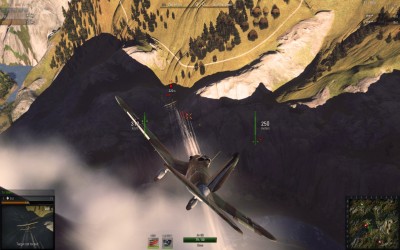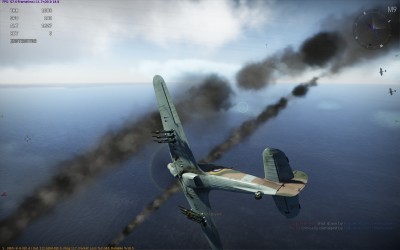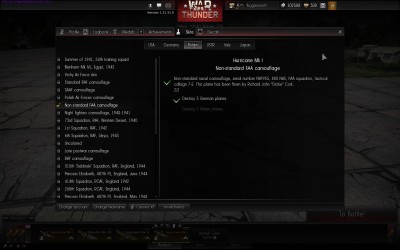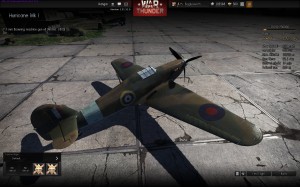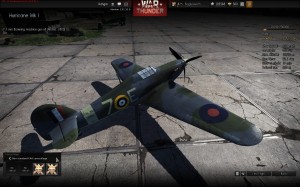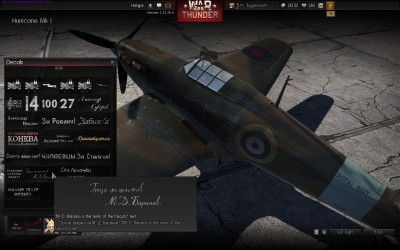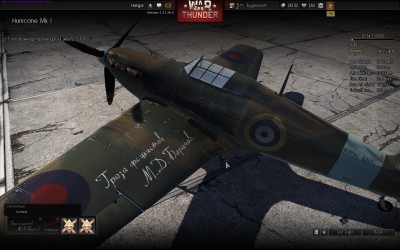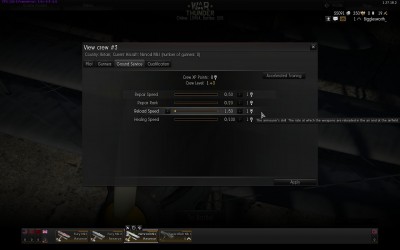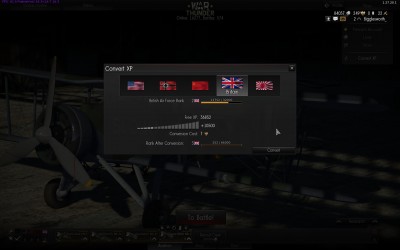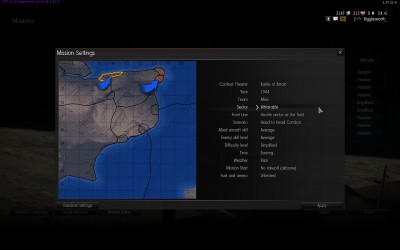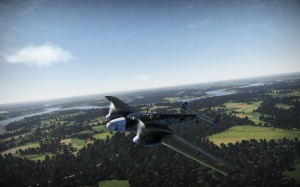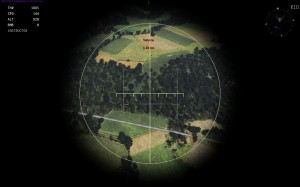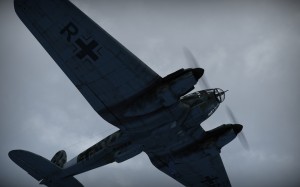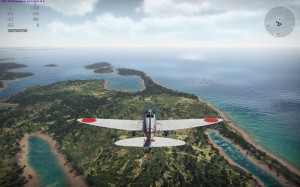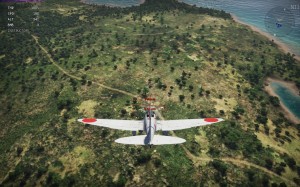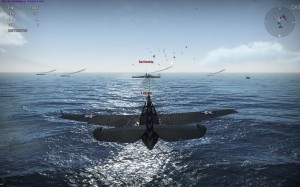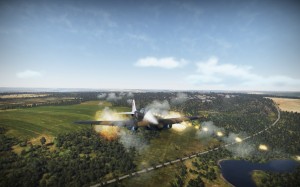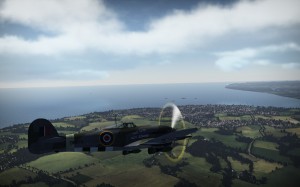In a world of World War Two aircraft at war, two games are going head-to-head: World of Warplanes and War Thunder. But which is better? There’s only one way to find out: play both of them and compare and contrast the relative features to determine which better suit personal preference!
(OK, two ways to find out. Moving on, before this turns into some sort of Spanish Inquisition…)
Both games are technically in beta, though at rather different phases; WT is in Open Beta that’s release in all but name, accepting money with a promise of no progress wipe prior to (official) launch, WoWP is in Closed Beta so changes are likely to be more significant and frequent. Being online games, though, they’re always going to be subject to change in the future, so apply suitable caveats (the quality of gameplay can go down as well as up, your premium status is at risk if you do not keep up repayments, objects in the rear view mirror are probably trying to shoot you down etc.) I can’t promise a completely balanced comparison as I’ve been playing War Thunder for three months and just dabbling in World of Warplanes for a week or two; it may be that I have an unconscious prejudice having become used to the way War Thunder does certain things, but short of obtaining a neuralyzer or attempting to induce amnesia I can’t get the perspective of a completely fresh player, and my dedication to impartiality only goes so far (stopping well short of massive head trauma).
Control Handling
One of the first things that jumps out when moving between the games is the difference in the way the planes handle when flown with mouse and keyboard. Aircraft in War Thunder are beautifully responsive. In Arcade and Realistic modes there is an “Instructor”; you wave the mouse around and point where you want to go, the Instructor handles all that complicated pitching and rolling and what-not so you don’t have to worry your pretty little head over it. This makes flying a much simpler business than in, say, Planetside 2; emboldened by my War Thunder success I tried to fly a Scythe fighter in PS2, and it didn’t end well. Although that might have something to do with PS2 having a lot more keys that need mapping, so when I pressed ‘E’ to apply a bit of rudder I’d forgotten it was actually the ‘enter/leave vehicle’ key, and promptly ejected.
Aircraft in World of Warplanes are also easy to fly with the mouse, but its version of the Instructor is a bit dozy; via To Game for Life, a post on Z’s Blog measures a 500ms delay in response to input, quite significant in high speed aerial combat. Apparently the controls in WoWP had a major overhaul in version 0.4.0, and more tweaks in the (current) 0.4.2 so it’s obviously something Wargaming is working on, but they just don’t feel great at the moment, especially when put up against WT.
Aircraft Selection
Both games feature hundreds of flyable aircraft from World War II (plus a few years either side), but with differing philosophies behind their selection. Gaijin look to have started off from a more historical perspective with the key aircraft of WWII for War Thunder, making their tech trees slightly ramshackle; some ranks unlock a whole swathe of new fighters, bombers and/or attack aircraft, other ranks have few or none. Wargaming, on the other hand, currently have full branches in World of Warplanes, completely populated from Tiers I to X for all nations, one aircraft per branch per tier (plus a few premium options). Classes are clearly delineated as well, each nation has one line of single seat/light fighters plus a second nation-specific line; heavy fighters for Gemany, attack aircraft for the USSR and carrier aircraft for the USA (Japan just has the one line of carrier fighters at the time of writing).
War Thunder has 20 Ranks compared to the ten Tiers of World of Warplanes, but the modular upgrade system of WoWP allows for greater variation within tiers, with aircraft able to upgrade the airframe, engine and armament, often quite substantially. The gun armament and basic powerplant of WT aircraft is fixed, so there’s not much to upgrade in a dedicated fighter; attack aircraft and bombers have more options with rocket and bomb payloads, some of which have to be unlocked. Individual crew also have skills to upgrade in WT, apparently crew skills will be added to WoWP in the future. War Thunder can look as though it has a lot more aircraft available, but it has separate instances of the Bf 109 G-2, G-6 and G-10 at Ranks 9, 13 and 14, whereas WoWP reflects those sub-variants in the various modules of the Tier VI Bf 109 G.
Neither approach is without issues; some branches of the War Thunder tech tree are horribly cluttered, most obviously the six Me 410 variants at Ranks 8 and 9; as you have to buy each one to unlock the next, if you want the Me 410 B-1/U-2 you have no choice but to buy the four preceding variants; condensing those into one or two main variants with multiple weapon options would clean things up. The upgrade system in World of Warplanes, though, looks like it brings the same issues as World of Tanks, where the excitement of unlocking a new vehicle is dampened by the knowledge that, without any upgrades, it’s almost certainly going to be pretty lacklustre, with any out-of-the-hanger improvements over its predecessor negated by harsher matchmaking. It’s not so bad in the lower tiers, where stooging around for a match or two while the rest of your team does the hard work (or catching a break from the matchmaker) nets enough XP to unlock some decent upgrades, but a right pain later on unless you use Free XP for rapid unlocks (probably the point, so you buy Gold for XP conversion).
From a gameplay perspective Wargaming’s trees makes sense, (presumably) well balanced and distributed. From a historical perspective, though, I’m not very keen. Almost all the Tier I to III aircraft are pre-war, many of them prototypes, with barely any combat service; Tiers IV through VII are much better, with your icons of WWII (Bf 109, P-51 Mustang, Il-2 Sturmovik, A6M Zero etc), but then Tier VIII+ is silly season with all sorts of oddities alongside occasional “proper” late-war or post-war jets. I don’t want to come across as some grumpy grognard getting furious about an improperly modelled supercharger intake, I’m not after a strict World War II simulator; the odd Flying Flapjack here and there is a bit of fun (as the actress said to the bishop), but, for me, I prefer the much stronger WWII flavour of War Thunder to the curiosities of World of Warplanes, your mileage may vary if you’re a fan of sellotaping Messerchmitts together.
Of course both games will get more aircraft over time; War Thunder has received several new planes in the last couple of major patches, and the site has planned tech trees showing quite a lot more aircraft to be added. Wargaming have talked about aircraft to be added to World of Warplanes, with the UK as the next nation to be added, so it will presumably follow in the footsteps of World of Tanks, which has received three new nations and scores of new tanks since release.
Game Modes
War Thunder has three game modes. In Arcade everyone piles in with random countries on both sides, automatically replenishing ammunition and bombs (after a short in-flight reloading delay) and you can respawn with as many planes as you have in the hanger of one country. Historical Battles use more realistic flight controls (without getting right into prop pitch and fuel mixture settings), national teams face each other (e.g. US vs Japan, UK/US/USSR vs Germany, or UK/US vs USSR in a Korean scenario), you select one of your aircraft and don’t get to respawn, and you have to return to base to rearm and repair so ammunition conservation is a lot more important, especially as Historical Battle maps are sizeable. Full Real Battles, using Simulation controls, are a bit like Historical Battles but you’re locked in cockpit view with no game HUD elements like the mini-map and target indicators, it’s down to you to squint for dots in the distance. You can also set up custom battles, either solo or with friends, with friendly and/or enemy AI if you don’t want to go up against random humans.
Within those game modes there are further battle types: Ground Attack and Domination in Arcade mode, where the objective is to destroy ground forces and capture airfields respectively, and Operations in the other modes, in which you support AI ground forces. Maps can have fixed emplacements, individual vehicles moving in convoy, and ships from patrol boats up to aircraft carriers, or you can always just ignore the stuff on the ground and shoot down enemy aircraft.
World of Warplanes has, so far, a single mode, an arcade-y battle of mixed nationalities on maps with a smattering of ground targets. Destroying buildings and aircraft earns your team points, you win by either shooting down the entire enemy team or gaining a decisive point advantage. It’s fine for a bit of a blast, but I’m not so sure about its long term prospects, and while different maps can have a tactical impact in World of Tanks, terrain plays rather less part when you’re flying over it, so other than a change in visuals and ground target positions the three maps I’ve seen so far don’t play very differently.
A key difference between World of Warplanes and the Arcade battles of War Thunder is that in the former you select a single aircraft and it’s game over when you’re shot down, in the latter you can respawn with as many aircraft as you have in your hanger (everyone starts with three; a fourth and fifth can be purchased, quite reasonably, for game-earned Silver Lions; further slots, up to eight I believe, cost real money Gold Eagles). There are pros and cons to ‘hanger battles’; personally I rather like being able to grab another aircraft from the hanger if you get shot down quickly by a lucky/unlucky shot, and being able to switch roles between air superiority and ground attack depending on how the battle is going. They can prolong fights, though, and the ability to respawn may make pilots less cautious in their manoeuvring, or more prone to deliberately ram the enemy (though there are still plenty of collisions in WoWP). The ability to buy additional crew slots and “Backup Plane” tokens for real money that allow you to use an aircraft twice in Arcade mode can be something of an advantage for players with bigger wallets, though unless I’m having a really bad time I can survive most fights with the five respawns that in-game currency buys, so I don’t regard it as a heinous flaw.
Matchmaking in War Thunder Arcade battles must be challenging, with players potentially having aircraft spanning five or more ranks in their hanger. Ranks 0 and 1 are kept together to give new players a chance to learn the ropes, after that you can easily be facing things several ranks above or below you; this can be pretty rough at major transitions, like when you get one Rank 2 aircraft, but by and large there isn’t a huge difference between ranks, more incremental increases in performance and armament, so you’re never a spare part and can always contribute in some capacity. World of Warplanes seems to use the matchmaker from World of Tanks, or something very similar, with Tier I and II aircraft in starter battles, then subsequent battles tending to span three tiers. Though this seems like tighter balancing than War Thunder, the difference between WoWP tiers is more pronounced, especially with component upgrades. Matchmakers are always something of a contentious subject, as exemplified by the current kerfuffle in WoT; both WT and WoWP seem reasonable enough at the moment, but you never really know how things may be tweaked in the future as the size and distribution of the playerbase changes.
While Wargaming are well known for adding new vehicles to World of Tanks, different game modes are another story; I’d like to see national battles and hanger/garage battles with both tanks and planes, but I’m not sure what the prospects are.
Damage Models
War Thunder uses a location based damage system; engines, control surfaces, pilots etc are all modelled, so a burst of fire can pass (relatively) harmlessly through a fuselage, or damage an aileron making a plane harder to control, or instantly kill your pilot. The exact model varies between game modes, generally being more forgiving in Arcade and becoming increasingly harsh in Historical and Full Real Battles; it’s also subject to tweaking, v1.29 saw a substantial overhaul that increased the number of locations modelled, but it needed a couple of minor patches to smooth the kinks out.
World of Warplanes has a hybrid model, with some location based damage (coarser than WT, I’ve experienced engine and wing damage so far with comparatively minor effect), but aircraft also have hitpoints, and are destroyed when their HP are reduced to 0.
War Thunder feels more realistic, and the model is a good part of the reason that there isn’t a huge difference between planes of different ranks, as anything can shoot anything else down, even a biplane vs a jet (albeit the jet would have to fly really quite badly). It can be frustrating, though, when you’re blazing away with seemingly little effect on an opponent, then someone lands one burst on you and hits your pilot. Large calibre weapons are also brutal, like the 37mm cannons of the P-39 and especially Yak-9T that can rip planes apart in one or two hits; in Historic Battles the fact that it has only 30 shells is something of a counterbalance, but in Arcade battles, with in-air reloading, it’s ludicrously good. It’s also annoying to survive an attack with seemingly little damage only to find your elevators have been destroyed and you have little or no control over pitch, consigning you to a long, slow glide to almost certain death; then again it can be exhilarating to glide home with no engine, or limp back to the airfield with one wing barely hanging on, land, and get repaired and back into action.
The hitpoint system of WoWP is more controlled, so you’ll seldom die from one shot (unless you go head-to-head with a rocket armed opponent), and higher tier aircraft have a more concrete advantage over lower. Heavy fighters and ground attack aircraft have many more HP than single engine fighters, so chasing one with a couple of machine guns can feel like an exercise in futility, especially with the lag in the control system making it more difficult to bring your weapons to bear. I bought the premium Tier V XFL-1, a prototype naval adaptation of the P-39, to see how scary a 37mm cannon would be, and it is powerful, without being quite so devastating as in War Thunder.
Economy
Both games have the same general set up with one type of currency earned in-game (Silver Lions/credits) and one purchased with real money (Golden Eagles/gold). Silver is used to buy new aircraft, upgrade them, and repair and rearm them between battles. Gold can be used to: purchase Premium account status for a period of time, granting bonus XP and silver; purchase Premium aircraft, comparable to standard aircraft of the same tier/rank, but that earn more XP and silver; convert free XP to allow for faster progress with an aircraft or nation; buy additional hanger/crew slots; and convert directly into Silver.
Economic discussions are tricky and get very emotive, with companies subject to accusations of greed, cash grabs, “pay to win”, implementing excessive grind, etc etc. Economies are also subject to change; War Thunder was substantially overhauled in v1.29, dramatically increasing the cost of higher rank planes and causing much vocal unhappiness, but I imagine the changes were necessary to slow players down a bit and get them to stick around, the age old problem that some people will get bored when they reach maximum level and leave, and others get bored if it takes too long to get to maximum level in the first place. Premium vehicles can also cause problems, as World of Tanks demonstrated with the Lowe and especially the Type 59; War Thunder is currently suffering from a glut of premium Fw 190 D-13s in Historical Battles, and it’s more of a balance issue in nation-vs-nation battles where only one side has access to the aircraft in question.
With World of Warplanes in closed beta and not taking money it’s impossible to directly compare the two at the moment, but I believe both games are eminently playable without spending any money at all; of course you won’t progress as quickly, but if you’re enjoying individual battles then that’s not such an issue.
Conclusion
With the games in their current states, it’s hard to look past War Thunder; better mouse controls, more game modes, and (for me) a more appealing selection of aircraft. World of Warplanes is fun enough to drop into, but once the novelty of rapidly unlocking new planes fades I’m not sure I’d stick with it for months or even years, though updates over the rest of beta and into launch could change that situation, and if you’re very keen on exotic aircraft prototypes or single-respawn arcade battles it may be the better choice. A shared economy with World of Tanks could be a further incentive for existing players; it’ll be interesting to see if the situations are reversed when War Thunder adds tanks.
With both games being free, as the ultimate cop-out I’d suggest giving both a try, unless your time or bandwidth are severely limited. Though that makes the rest of this post a bit pointless. In hindsight maybe I should have just opened with that, and saved us all a lot of time. Oh well! If you have a preference for one or the other, do leave a comment, I’m curious to see what features other players consider more or less important.
